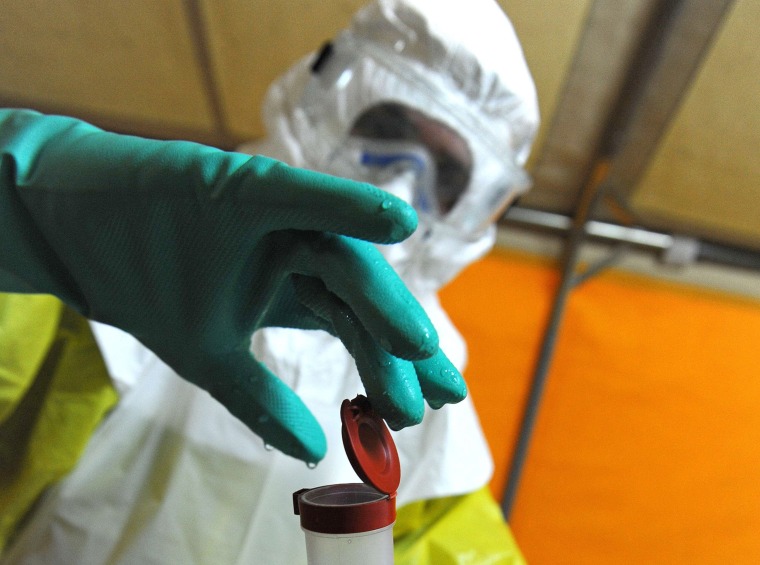A U.S. healthcare worker being treated for Ebola at the National Institutes of Health has few treatment options. Scientists are working to speed some experimental therapies through the testing process, but there’s nothing tried and true available yet.
The patient, who isn’t being identified, arrived early Friday at the NIH outside Washington, D.C. He or she — the NIH isn’t giving a gender or any other identification — is listed in serious condition.
Doctors have found that supporting patients by replacing fluids lost to diarrhea and vomiting helps them survive, so the patient will get intravenous saline, with carefully measured minerals called electrolytes.
This is the 11th person being treated for Ebola in the U.S. The last patient, Dr. Craig Spencer, recovered in December.
The 10 previous patients got a range of treatments but no one’s sure if they helped. Here’s what’s available now:
ZMapp
ZMapp is a cocktail of antibodies designed to fight Ebola.
A company called Kentucky BioProcessing grows ZMapp's antibodies in tobacco plants. The U.S. government worked with Mapp Biotherapeutics to speed up the process and has signed agreements with other companies to help grow the engineered monoclonal antibodies in other ways. There’s enough now to start a clinical trial in Africa. The first U.S. Ebola patient, medical missionary Dr. Kent Brantly, was given a course of ZMapp.
TKM-Ebola
This drug, made by a Canadian company called Tekmira, uses bits of genetic material called small interfering RNAs, or siRNAs for short. Viruses kill cells by invading them and taking over their machinery to force them to pump out copy after copy of virus. This drug doesn’t prevent infection, but stops the virus from replicating by attaching to its RNA.
Tekmira starting testing the drug this week in patients in Sierra Leone. Dr. Rick Sacra got the drug while he was treated for Ebola last year in Nebraska.
Favipiravir
French researchers are testing a Japanese flu drug called favipiravir in Guinea. Initial results suggest it might help patients who are not too sick yet.
Favipiravir would be far easier to use than ZMapp. It's a pill; ZMapp must be kept frozen in a tube and infused. Another pill that researchers hoped would work is brincidofovir, made by North Carolina-based Chimerix. But the company's withdrawn its support for those tests.
Plasma
Researchers in the U.S. and Liberia are collecting blood plasma from Ebola survivors to see if infusing it into patients can help kick-start their immune response to Ebola. Medical missionary Nancy Writebol, the second American to be infected with Ebola, regularly donates plasma for testing. Writebol and Brantly both have donated their plasma to treat other Ebola patients.
Cattle plasma
SAb Biotherapeutics has a herd of cattle genetically engineered with human DNA so that their bodies don't produce cattle antibodies but human antibodies. They're cloned to make a herd of genetically identical, part-human animals.
Then they are vaccinated against various deadly diseases such as Ebola. Their bodies produce antibodies in response to these vaccines, and the hope is these antibodies can be used to treat people with the diseases.
Vaccines
Two vaccines are being tested against Ebola in Guinea, Sierra Leone and Liberia.
One is made using a "live" virus called vesicular stomatitis virus (VSV) genetically engineered to carry a small, non-infectious piece of Ebola virus. By design, the vaccine causes a mild infection that activates the immune system and helps it recognize Ebola.
A company called NewLink Genetics worked with NIH to make this one, and it’s now licensed to vaccine giant Merck for testing.
The National Institute of Allergy and Infectious Diseases, part of NIH, is working with vaccine maker GlaxoSmithKline to develop another vaccine, which uses a common cold virus called an adenovirus that normally infects chimpanzees. It doesn't cause any symptoms in people. It's genetically engineered with a small piece of Ebola virus and, in theory, should also prompt the immune system to recognize and attack Ebola.
The CDC is preparing a trial and will work with Sierra Leonean authorities to vaccinate up to 6,000 health care workers, including doctors, nurses and ambulance drivers, against Ebola starting later this month.
The vaccines are an example of an unprecedented acceleration of research to battle a disease in real time.
